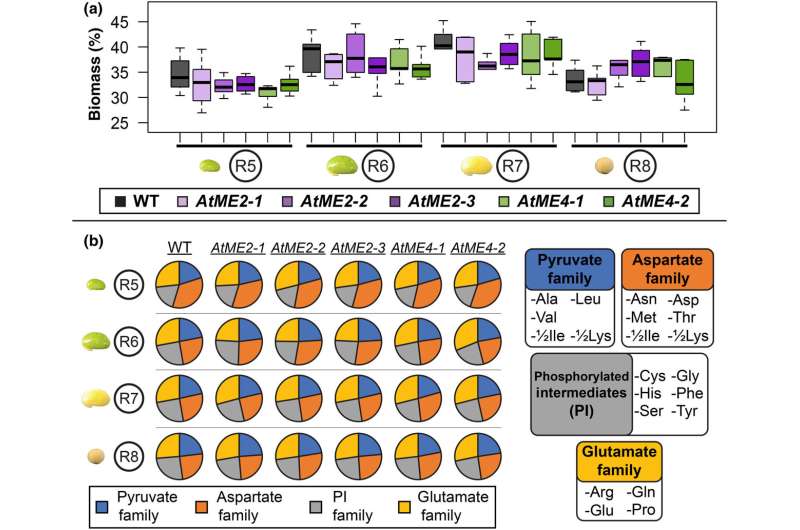This article has been reviewed according to Science X's editorial process and policies. Editors have highlighted the following attributes while ensuring the content's credibility:
fact-checked
peer-reviewed publication
trusted source
proofread
Research reveals how a single enzyme can boost soybean oil production

As a potent source of protein and oil, soybeans are a vital global crop for food, animal feed, industrial applications, and biofuel production. Even minor improvements in soybean seed content can therefore have far-reaching implications for agricultural productivity and global economies.
Research led by Doug Allen, Ph.D., USDA-Agricultural Research Service scientist and member at the Donald Danforth Plant Science Danforth Center, uncovered an important role played by malic enzyme in enhancing soybean oil production. Their work, "Expression of malic enzyme reveals subcellular carbon partitioning for storage reserve production in soybeans," was recently published in the journal New Phytologist.
Under the direction of Stewart Morley, Ph.D., postdoctoral associate in the Allen Lab, the research team investigated the role of malic enzyme in soybean seed composition. Malic enzyme is a crucial component of central carbon metabolism, or rather the set of chemical reactions that take place inside cells to convert energy into the building blocks needed for a cell to grow and function properly.
Malic enzyme provided the conduit between two important metabolite nodes in central metabolism and can impact carbon allocation to boost oil production. Enhancing malic enzyme activity, increased soybean seed oil levels and altered the fatty acid profile within the bean, findings that could be important for developing sustainable green-fuels and petroleum replacements.
"Malic enzyme provides an elegant solution to increasing oil content," said Morley, as their research demonstrates the potential to enhance oil production in soybeans by strategically manipulating just a single enzymatic step. The work examining the role of malic enzyme in carbon partitioning and central metabolism was a first proof in plants that altering this step could enhance lipids and was predicated on prior metabolic flux studies from the lab.
The publication generated a commentary by Jorg Schwender, Ph.D. senior scientist, Brookhaven National Laboratory, who noted that their study "put the insights they have gained into the delivery of metabolic precursors and energy cofactors to oil synthesis to the test and arrive at a successful metabolic engineering design."
This study relied on the state-of-the-art core facilities at the Danforth Center, including the Mass Spectrometry and Proteomics and Plant Growth facilities, and the Advanced Bioimaging Laboratory. "The capacity to produce impactful, rigorous science comes from leveraging the expertise and instrumentation available here at the Center," noted Allen.
Their work also benefited from cross-collaboration with institutions like the University of Nebraska-Lincoln and Saint Louis Community College, which provided access to the specific "digital droplet" qPCR instrument that the team used to determine expression levels of malic enzyme. "This research would not have been possible without the support and collaborative effort of others in these facilities and academic institutions," Allen pointed out.
Looking ahead, Morley plans to explore further avenues for enhancing soybean oil production, such as crossing malic enzyme-modified soybean lines with other lines engineered to boost oil production, potentially unlocking further gains in lipid production.
The implications are for a promising future where soybean crops can be tailored to meet evolving market demands and contribute to sustainable agriculture, food security, and renewable energy production. In addition, the impact of this research can potentially extend beyond soybean by offering insights into lipid production in other crops and leveraging genetic engineering to improve seed quality.
More information: Stewart A. Morley et al, Expression of malic enzyme reveals subcellular carbon partitioning for storage reserve production in soybeans, New Phytologist (2023). DOI: 10.1111/nph.18835
Jorg Schwender, Walking the 'design–build–test–learn' cycle: flux analysis and genetic engineering reveal the pliability of plant central metabolism, New Phytologist (2023). DOI: 10.1111/nph.18967
Journal information: New Phytologist
Provided by Donald Danforth Plant Science Center





















